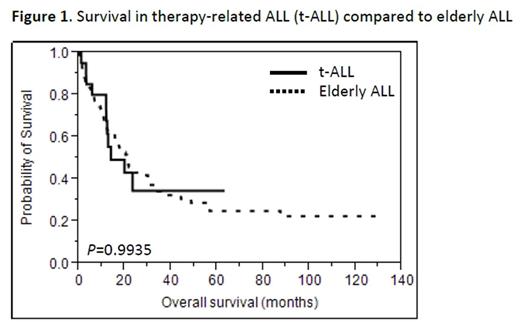Abstract
Introduction
Therapy-related ALL (t-ALL) is a rare entity. It was recently estimated to occur in about 4.7%-6.9% of adult ALL cases and has been associated with a worse prognosis(Aldoss et al ., 2017; Abdulwahab et al ., 2012). However, these studies included very few patients over the age of 60. Since t-ALL specifically in the elderly has never been described, we sought to characterize its clinical features and treatment outcomes.
Methods
After IRB approval, we performed a retrospective study of patients (pts) ≥60 years old diagnosed with ALL from 2000-2017 at Mayo Clinic Rochester, Arizona, and Florida. We included pts who received known leukemogenic chemotherapy prior to being diagnosed with ALL. We excluded pts with malignancies who were not exposed to leukemogenic chemotherapy. We also excluded pts diagnosed with chronic myeloid leukemia (CML) with blast crisis. Moreover, we excluded pts treated with radiation therapy other than to the whole pelvic region. Statistical analysis was performed using JMP 10.0 software.
Results
Baseline characteristics
Out of 124 consecutive pts with elderly ALL, we identified 20 (16%) pts who fit our inclusion criteria. 16 (80%) were female. The median latent time to developing ALL was 9.25 years (range 0.26-28.67). The median time of follow-up was 12.6 months (range 0.9-63.2). 11 (55%) were deceased at the time of follow-up: 3 deaths related to disease, 6 from infection or other causes, and 2 unknown.
Of the 20 pts with t-ALL, 13 (65%) had been treated for hematological malignancies prior to ALL, which included multiple myeloma (3), acute myeloid leukemia in remission (2), diffuse large B-cell lymphoma (2), myelofibrosis (2), myelodysplastic syndrome (1), MALT lymphoma (1), hairy cell leukemia (1), chronic lymphocytic leukemia (1), and light-chain (AL) amyloidosis (1). Additionally, 6 pts had prior treatment for breast cancer; 1 of these was the pt who also had AL amyloidosis. Finally, 1 pt had a history of receiving cyclophosphamide for bronchiolitis obliterans with organizing pneumonia and myositis.
Median age at time of ALL diagnosis was 67 (60-82). 19 (95%) had B-cell ALL, of which 5 (26%) were positive for the Philadelphia chromosome. Only 1 (5%) pt had T-cell ALL.
Cytogenetics and FISH studies
18 pts had available cytogenetic data at time of diagnosis. 8 (44%) had complex cytogenetics (≥5 abnormalities), 7 (39%) had a monosomal karyotype, 4 (22%) were hyperdiploid, 2 (11%) were hypodiploid, 1 (6%) was a mixture of hyper- and hypo-diploid. Furthermore, FISH analysis was available in 10 pts: 3 had CDKN2A deletion, 2 had a duplication of 1q, 2 had a TCF3-PBX1 translocation, 1 had a MLL rearrangement, and 1 had a deletion of IKZF1 .
Treatment and Outcomes
15/20 (75%) underwent induction chemotherapy. 6 of them received Hyper-CVAD. The other 9 received various regimens, including asparaginase-based chemotherapy in 6 (67%). 13 (87%) had a complete remission (CR/CRi), within a median time of 32 days (range 19-128). 1 (7%) had primary refractory disease. The other 5 (25%) pts chose palliative treatment up-front; this included chemotherapy (e.g. vincristine and steroids), tyrosine kinase inhibitors, or hospice. 3 (60%) of these pts got into CR.
Of the 16 total pts who achieved CR, 5 (31%) relapsed within a median time of 20.67 months (range 9-22.3). All of them were treated with salvage chemotherapy. Median survival after relapse was 4.8 months (range 0.1-42.2). Overall, 7/20 (35%) underwent allogeneic HSCT; all were in CR1. Median survival after HSCT was not reached (IQR 7.6-NR). Only 2 (29%) relapsed after HSCT within a median time of 6.4 months (range 3.1-9.6).
The median overall survival (mOS) in patients with t-ALL was 13.83 months (interquartile range [IQR] 11.73-not reached), which was not significantly different (P=0.9935) from elderly patients without t-ALL, who had a mOS of 20.93 months (IQR 8.73-56.63) (Figure 1).
Conclusions
Therapy-related ALL (t-ALL) seems to be relatively more common in the elderly compared to younger adults, with an incidence of 16% in our elderly ALL cohort. Almost all cases were B-cell ALL. In addition, MLL rearrangements appeared to be less frequent in our elderly cohort (7%), in contrast to what has been reported in younger adults (25-35%). Moreover, the overall survival in elderly t-ALL was not significantly different compared to elderly ALL.
No relevant conflicts of interest to declare.
Author notes
Asterisk with author names denotes non-ASH members.


This feature is available to Subscribers Only
Sign In or Create an Account Close Modal